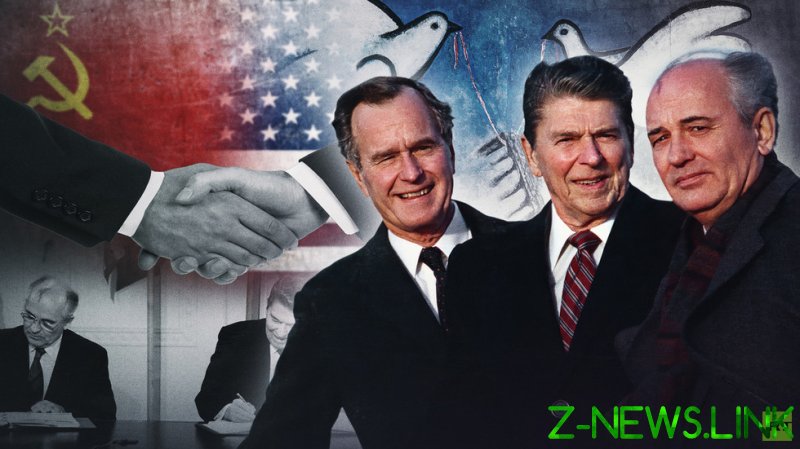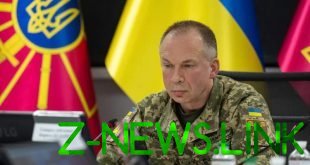
If you Google “the end of the Cold War,” the search engine will instantly tell you that this event occurred on December 26, 1991, the day when the Soviet Union ceased to exist. However, this isn’t really true. Two years prior to that, the leaders of the US and the USSR officially declared the end of the confrontation that had lasted for over 40 years.
The tension that grew between the two superpowers in the 1980s was eventually eased through joint diplomatic efforts. The trust established between the Kremlin and the White House in those years not only inspired the United States to consider integrating the USSR into the new system of international relations in the early ‘90s, but also moved it to prevent the collapse of the ‘Red Empire’.
But why did Washington suddenly become a friend of its sworn enemy? And at what point did this friendliness give way to uncompromising statements about winning the Cold War and the United States’ triumphant ‘dance’ on the ashes of its deceased enemy?
A thorny path
In the last decade of the Cold War, the situation on the global chessboard did not play out in favor of the USSR. The Soviet economy was considerably weakened by a protracted arms race, which the US only accelerated. At the end of 1983, Washington placed the first battery of Pershing II missiles in Europe. These could reach targets in the western part of the USSR in only six to eight minutes.
At the same time, the US started talking about a new type of nuclear strike against the USSR – a ‘decapitation’ (or ‘blinding’) attack that would remove the country’s leadership before the decision to conduct a retaliatory strike could be made. In 1984, then-president Ronald Reagan launched the ‘Star Wars program’, which threatened to expand the Soviet-American conflict into outer space.
But even before these events, the Soviet leadership feverishly sought a compromise with the United States. Yury Andropov, the then general secretary, tried to reach an agreement with Washington, but his initiative was scuppered by the tragic downing of a Korean Air Lines Boeing 747, after which Reagan made his famous speech, calling the USSR an “evil empire.”
Hopes of ending the conflict instantly disappeared. Tension only increased and reached a record, 30-year high. At that point, the USSR decided continuing negotiations would be a sign of weakness on its part. The dialogue came to naught, and left both parties fearing a nuclear strike.
Everything changed when Mikhail Gorbachev came to power. Contrary to the military’s advice and without any pressure from the United States, he decided to take the first step and make concessions. First, in 1985, the leadership of the Soviet Union unilaterally imposed a moratorium on the deployment of ‘Oka’ operational-tactical missile complexes in Czechoslovakia and the German Democratic Republic (GDR). This was followed in January 1986 with the announcement by the USSR of a step-by-step worldwide nuclear disarmament campaign.
“As I face you today, I want to say that Soviet people are dedicated to peace, that supreme value equal to the gift of life … Let us commit ourselves to doing away with the threat hanging over humanity,”
Gorbachev said at the time.
This put the ball in Washington’s court. Whether the gesture by the Soviet leader would initiate the end of the lengthy conflict depended only on the US. Ronald Reagan took the ball and ran with it.
Long-awaited detente
A special relationship soon developed between the two leaders, and the USSR and US quickly moved from strategic arms restrictions to a more radical disarmament policy. The first joint document was the Intermediate-Range Nuclear Forces Treaty (INF), signed in December 1987, which banned short and medium-range and intermediate-range missiles. The parties pledged to destroy all complexes of ballistic and ground-launched cruise missiles of intermediate (1000-5500 kilometers) and short-medium (500-1000 kilometers) range, and not to produce, test, or deploy such missiles in the future.
At the Malta Summit in late November/early December 1989, Gorbachev and Reagan’s successor George H.W. Bush announced the end of the Cold War. The representative of the USSR’s Ministry of Foreign Affairs, Gennady Gerasimov, stated that the Yalta Agreements of 1945 (i.e., the post-war division of Europe into areas of influence) had been replaced by what he called the ‘Sinatra Doctrine’, giving the former Eastern European satellite nations the freedom to do things “their way.” The Yalta Agreements were officially buried.
In 1990, the USSR agreed on the reunification of Germany within the framework of NATO – which essentially meant that the socialist East was swallowed up by the capitalist West. The USSR promised to withdraw its troops from the East German territories within four years, and from other countries of the Warsaw Pact even sooner.
In the same year, Gorbachev also signed the Treaty on Conventional Armed Forces in Europe (CFE), which drastically reduced the number of Soviet troops in other parts of Europe and eliminated the possibility of a large-scale surprise attack. Within the framework of the CFE Treaty, the Soviet side had to drastically reduce its military presence and obey strict restrictions on the movement of troops. The USSR also had to carry out a large-scale redeployment of its military contingents. The new non-hostile relations between the countries of the Euro-Atlantic region were enshrined in the declaration signed in November 1990 – ‘The Charter of Paris for a New Europe’.
Gorbachev’s policy was inspired not only by altruism and a desire for peace. The main reason he revised the USSR’s foreign policy course was because he wanted to slow down the arms race, which had placed an unbearable burden on the Soviet economy.
The latter, however, does not diminish the Soviet leader’s courage. Behaving in a restrained manner and not allowing the United States – which was economically and technically superior to the USSR – to drag the country into another round of an intensifying arms race was a policy that past generations of Soviet leaders could not even imagine.
Hungry hawks
Gorbachev’s calculations seemed to be right. In May 1991, George H.W. Bush declared that the United States wanted to move away from the policy of containment and “integrate the Soviet Union into the commonwealth of the peoples.” At the time, he had a series of meetings with Gorbachev that largely determined the further actions of both sides.
The process of stabilizing international relations continued, and in the summer of the same year, the START-I treaty was signed, which significantly limited the nuclear arsenals of both powers.
Not everyone, however, was happy with how things were going. Despite the fact that many positive changes occurred and the threat of a global nuclear war was resolved, Bush was criticized in the United States for treating the USSR too favorably. For example, before the August Coup [an attempt by Soviet reactionaries to carry out a coup d’état and remove Gorbachev from power – RT], the White House had been reluctant to contact Boris Yeltsin and his entourage, and, in July 1991, Mikhail Gorbachev was even invited to London for the G7 summit.
All this greatly displeased the ‘hawks’ in the US (for example, then-secretary of defense Dick Cheney and former president Richard Nixon), who believed that with the technology and loans provided to it, the USSR could pose an even greater threat than before. These circles of the American establishment wanted to take advantage of the internal problems that came up during democratic reforms in the Soviet Union and thereby secure its collapse.
However, Bush preferred negotiations with the socialist regime over its imminent collapse. The White House feared that, if civil war were to break out in the USSR, its nuclear arsenal could be dispersed all over the world.
The US president’s position was clearly stated in his August 1, 1991 speech in Ukraine, which journalists dubbed the ‘Chicken Kiev speech’.
Supporters of an independent state eagerly anticipated the US leader’s arrival in the capital and hoped that he would support democratic trends in the republic. But the White House decided otherwise. Bush declared that the separation of the Ukrainian SSR or other Union republics from the USSR was inadmissible. “Americans will not support those who seek independence in order to replace a far-off tyranny with a local despotism. They will not aid those who promote a suicidal nationalism based upon ethnic hatred,” Bush said during a solemn meeting of the Supreme Soviet of the Ukrainian SSR,
Nevertheless, the USSR collapsed a few months after Bush’s Kiev visit. Some 23 days after his speech, Kiev adopted the ‘The Act of Declaration of Independence of Ukraine’ and, four months later, it was confirmed by referendum. Soon enough, the other republics also left the Soviet Union.
A world without peacemakers
The events of 1991 took not only the USSR, but also the US by surprise. For over 40 years, American elites wanted to win the Cold War, but it turned out that they were completely unprepared for victory. The Bush administration was even forced to support Gorbachev in his struggle against Yeltsin and other Republican leaders who wanted to dissolve the Soviet Union.
Except for some fierce ‘hawks’, no one in the USA really wanted the USSR to collapse. The US goal was to dismantle the socialist system outside of the Soviet Union. Americans were interested in dissolving the Warsaw Pact and the Council for Mutual Economic Assistance (COMECON). They wanted Soviet troops to withdraw from the socialist countries in Eastern Europe and for the USSR to stop providing military and economic assistance to regimes in Africa, Asia, and Latin America.
In fact, all the key issues of the Soviet-US confrontation were resolved in favor of the United States even before 1991, and prior to the collapse of the USSR. In the last years of the ‘80s, arms limitation treaties were signed, the Warsaw Pact and COMECON were dissolved, and the USSR began gradually withdrawing its troops from Europe. In 1990, the article of the USSR Constitution on the leadership role of the CPSU was abolished – the ‘Red Empire’ was no longer the ‘moral authority’ for socialist regimes worldwide.
The collapse of the USSR, however, brought a risk of political instability to Europe (considering not only the nuclear, but also the conventional weapons remaining in Soviet arsenals) and would deprive the United States of a 300 million-strong sales market united by common economic chains and a joint customs space. If the Soviet Union had not collapsed, American corporations would have had access to its huge reserves of oil, gas, and other minerals. Moreover, preserving the USSR in a weakened state was also beneficial for the US foreign policy model. The Soviet Union was no longer strong enough to challenge the United States, but it could have become a convenient partner for solving global security problems.
In the first years after the Cold War, the United States was in no hurry to attribute victory to itself and adopted the stance of an equal partner towards the Russian state.
According to the director General and member of the Presidium of the Russian Council for International Affairs, Andrey Kortunov, the victory of the US wasn’t as important as the defeat of the USSR for the Bush administration. However, under the administration of his successor, Bill Clinton, Americans adopted the concept of a ‘unipolar world’. Declaring that they had defeated the Soviet Union, they attempted to instill ‘democratic’ doctrines in the Middle East and Central Asia.
In 1992, the Clinton administration embarked on a much more aggressive course in the post-Soviet space, consolidating its position as the winner of the Cold War and establishing US dominance. Under Clinton, the policy of containing Russia became more systematic and intense. The United States tried not only to make the most of the collapse of the USSR, but also attempted to prevent the emergence of a Russian-centric economic and political space in of the former Soviet empire.
By Petr Lavrenin, Odessa-born political journalist and expert on Ukraine and the former Soviet Union
© 2023, paradox. All rights reserved.





